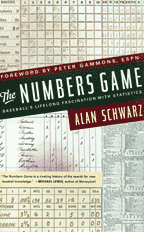
By Alan Schwarz C’90.Thomas Dunne Books 2004. $24.95.
In the introduction to The Numbers Game: Baseball’s Lifelong Fascination with Statistics, Alan Schwarz C’90 makes it clear that he had little interest in writing a book about the statistics themselves. Rather, he says, he wanted to write “about the people obsessed with baseball’s statistics ever since the box score started it all in 1845: The zealots who keep them, the fans who devise them, the scientists—some of them Nobel laureates—who pursue a grand unifying theory for them.”
He succeeds brilliantly, sketching those zealots and fans and scientists to life with clear, vigorous prose. And in doing so, he makes even those of us whose eyes glaze over at Baseball Prospectus’s complex algorithms care about the statistics—those seductive, sometimes-illusory rivers of numbers that have flowed through the game since before the Civil War.
While not writing about the stats per se—and you’ve got to like a guy who says that PECOTA “stands for a convoluted phrase not worth knowing”—Schwarz does a terrific job of explaining their significance and putting them in historical context. “Those trampled in recent years by the march of on-base percentage wonder where in the world this thing came from,” he writes. “The statistic has become baseball’s version of rock and roll, scaring the old and galvanizing the young—the ousted generation blaming it for everything gone wrong, wondering what happened to the world they used to know.” And yet, he adds: “Little do these folks know, the roots of on-base percentage, the effort to quantify and appreciate the skill not of getting hits but of avoiding outs, stretch back all the way to Henry Chadwick”—who, in the 1860s, “kept a statistic he called Outs Per Game as a measure of batting failure.” Walks, a key component of on-base percentage, were essentially ignored in baseball stats after 1887, Schwarz reveals. And despite the efforts of people like F.C. Lane (who in 1917 called walks “the orphan child of the dope sheets”) and the dynamic Brooklyn Dodgers’ duo of Allan Roth and Branch Rickey, on-base percentage had only a “small cult following until computers allowed researchers to prove just how meaningful the statistic truly was.”
Schwarz also does a bang-up job tracing the rise of sabermetrics, which was defined by its most famous proponent, Baseball Abstractauthor Bill James, as “the search for objective knowledge about baseball.” (James coined the term from SABR, the acronym for the Society for American Baseball Research.) He documents some of the bitter feuds within the statistical community—noting, for example, that Seymour Siwoff, the paranoid president of the Elias Sports Bureau, “refused to be interviewed for this book and threatened termination to any Elias employee who was, because the name ‘Bill James’ was in its pages.”
Ultimately, it was just a matter of time before the computer-aided sabermetricians would infiltrate the smarter front offices of Major League Baseball. (For more on that, see Michael Lewis’s Moneyball.) And there is no turning back. “In 2002, my survey of 50 baseball executives found that exactly half had learned the game in large part by playing Strat-O-Matic as kids,” notes Schwarz. “That number will only grow.”
Those who fear that this obsession with numbers will undermine the game’s lyrical possibilities should consider a small item tucked away on page 61: “One imaginative teenager in Lowell, Massachusetts, in 1935 invented an entire universe with more than 100 fictional ballplayers on six teams he named after cars, like the Pontiacs and the Chevvies, and kept detailed stats in addition to writing a league newsletter. His name was Jack Kerouac.” —S.H.




